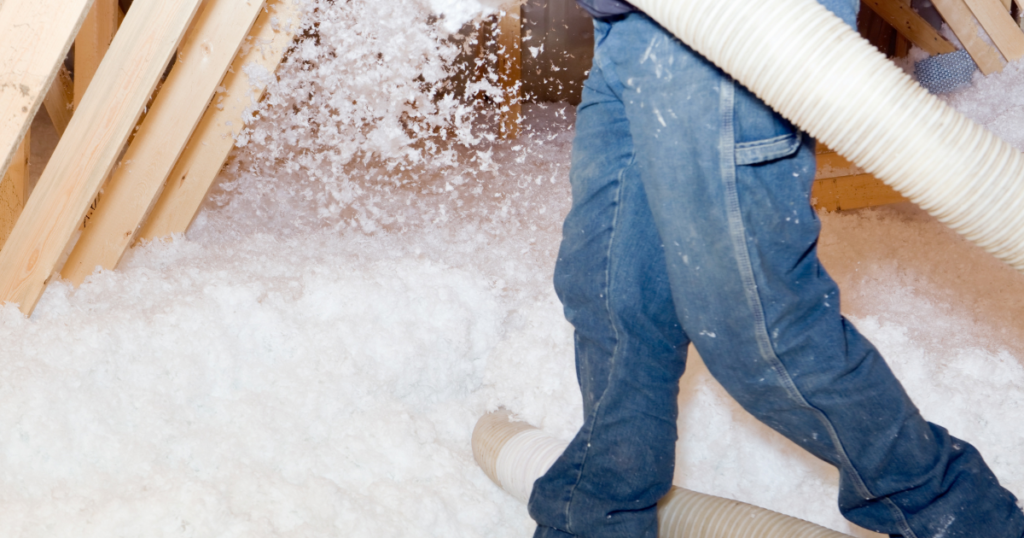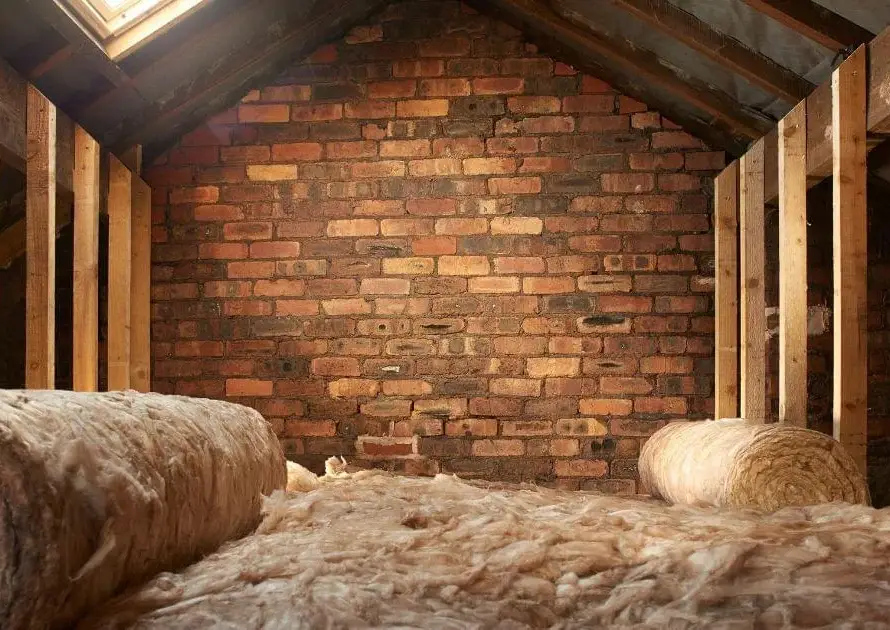In the quest for energy efficiency and comfort, homeowners often focus on attic insulation as a key element of their home improvement efforts. While proper insulation is crucial for maintaining a comfortable living environment and reducing energy costs, it can sometimes inadvertently contribute to a serious problem: mold growth.
Mold is a common issue in many homes, often lurking in dark, damp spaces out of sight. It’s not just an unsightly nuisance; mold can pose significant health risks to you and your family. Exposure to mold spores can trigger allergic reactions, respiratory problems, and other health issues, particularly in individuals with pre-existing conditions or weakened immune systems.
When it comes to mold growth, attics are particularly vulnerable. The combination of warm air rising from living spaces below, potential roof leaks, and inadequate ventilation can create an ideal environment for mold to thrive. This is why addressing mold issues in attics is of paramount importance for maintaining a healthy home.
In this article, we’ll explore the relationship between attic insulation and mold growth, helping you understand the risks and providing practical solutions to ensure your home remains both energy-efficient and mold-free. By taking proactive steps to prevent and address mold in your attic, you can protect your home’s structural integrity and, more importantly, safeguard your family’s health.
Understanding Mold Growth

To effectively combat mold in your attic, it’s crucial to understand how it forms, spreads, and thrives. This knowledge will empower you to identify potential problems early and take appropriate preventive measures.
How Mold Forms and Spreads:
Mold is a type of fungus that reproduces by releasing tiny spores into the air. These spores are present everywhere, both indoors and outdoors. When these spores land on a damp surface with adequate nutrients, they begin to grow and multiply. In homes, mold can feed on various materials, including wood, drywall, fabric, and even dust.
Once established, mold colonies can spread rapidly under the right conditions. They release more spores into the air, which can settle on nearby surfaces, starting new colonies. This cycle can continue undetected, especially in less frequently visited areas like attics.
Common Conditions Leading to Mold Growth in Attics:
Attics are particularly susceptible to mold growth due to several factors:
- High humidity: Warm, moist air rising from living spaces can become trapped in the attic.
- Poor ventilation: Inadequate air circulation can prevent moisture from escaping.
- Roof leaks: Even small leaks can introduce enough moisture to support mold growth.
- Condensation: Temperature differences between the attic and outside air can cause condensation on surfaces.
- Improper insulation: Gaps or compressed insulation can lead to cold spots where condensation forms.
Types of Mold Commonly Found in Homes:
While there are thousands of mold species, several types are frequently found in homes:
- Aspergillus: A common indoor mold that can cause respiratory issues.
- Penicillium: Often found on water-damaged materials and can cause allergic reactions.
- Stachybotrys (Black Mold): Grows on materials with high cellulose content and chronic moisture. Known for its potential toxicity.
- Alternaria: Often found in damp areas and can cause allergic responses.
- Cladosporium: Can grow in both warm and cold conditions and may trigger asthma symptoms.
It’s important to note that while some molds are more hazardous than others, all mold growth in homes should be addressed promptly. Regardless of the type, extensive mold growth can compromise your home’s structural integrity and indoor air quality.
Understanding these basics about mold growth will help you recognize potential issues in your attic and take timely action to prevent or address mold problems, ensuring a healthier living environment for you and your family.
Health Risks Associated with Mold

While mold plays a vital role in nature, its presence in our homes can lead to various health issues. Understanding these risks is crucial for recognizing the importance of mold prevention and remediation, especially in less visible areas like attics.
Respiratory Issues: Asthma, Allergies, and Infections
- Asthma:
- Mold spores can trigger asthma attacks in those who already have the condition.
- Prolonged exposure may contribute to the development of asthma in previously unaffected individuals.
- Symptoms include wheezing, coughing, chest tightness, and shortness of breath.
- Allergies:
- Many people are allergic to mold spores, leading to symptoms similar to hay fever.
- Common reactions include sneezing, runny or stuffy nose, itchy or watery eyes, and skin rashes.
- In some cases, these allergic reactions can be severe and require medical attention.
- Infections:
- While rare, certain molds can cause respiratory infections, particularly in people with weakened immune systems.
- Aspergillosis, caused by Aspergillus mold, can lead to lung infections and, in severe cases, spread to other organs.
Impact on Individuals with Compromised Immune Systems
People with weakened immune systems are particularly vulnerable to mold-related health issues:
- Those undergoing chemotherapy or radiation therapy
- Organ transplant recipients
- Individuals with HIV/AIDS
- People with autoimmune diseases
For these individuals, exposure to mold can lead to more severe infections that may be difficult to treat. In extreme cases, these infections can be life-threatening.
Long-term Health Effects of Mold Exposure
While more research is needed, studies suggest that prolonged exposure to mold may lead to:
- Chronic respiratory conditions: Persistent sinus infections, bronchitis, or pneumonia.
- Neurological symptoms: Some people report memory problems, headaches, and mood changes after long-term mold exposure.
- Chronic Inflammatory Response Syndrome (CIRS): A controversial diagnosis suggesting that some individuals may develop a multisystem, multi-symptom illness after mold exposure.
- Potential link to other health issues: Some research suggests possible connections between long-term mold exposure and conditions like chronic fatigue syndrome, though more studies are needed to confirm these links.
- Mycotoxin exposure: Certain molds produce toxins that, when inhaled over long periods, may contribute to various health problems, including liver and kidney issues.
It’s important to note that while these long-term effects are concerning, they are not inevitable. Prompt identification and remediation of mold problems can significantly reduce the risk of developing these health issues.
Given these potential health risks, it’s clear that addressing mold growth in your home, including hidden areas like attics, is not just about maintaining your property – it’s about protecting your family’s health. Regular inspections, proper ventilation, and quick action at the first sign of mold can go a long way in ensuring a safe and healthy living environment.
How Attic Insulation Prevents Mold Growth

Proper attic insulation plays a crucial role in preventing mold growth by addressing three key factors: moisture control, temperature regulation, and air sealing. Let’s explore how each of these aspects contributes to maintaining a mold-free attic environment.
Moisture Control: Reducing Humidity Levels in the Attic
Effective insulation helps control moisture in the attic in several ways:
- Vapor barrier: Many insulation materials, like faced fiberglass batts, come with a built-in vapor barrier that prevents moisture from passing through.
- Absorption and release: Some types of insulation, such as cellulose, can absorb excess moisture and release it slowly, helping to maintain consistent humidity levels.
- Preventing air movement: By reducing air movement between the living space and the attic, insulation minimizes the transfer of humid air into the attic.
- Supporting ventilation: Proper insulation installation leaves space for ventilation, allowing moist air to escape and keeping the attic dry.
Temperature Regulation: Preventing Condensation and Dampness
Insulation’s primary function is to regulate temperature, which indirectly helps prevent mold growth:
- Reducing temperature fluctuations: Insulation minimizes dramatic temperature changes in the attic, which can lead to condensation when warm air meets cold surfaces.
- Creating a thermal barrier: By separating the warm living space from the cooler attic, insulation prevents the warm, moist air from reaching cold attic surfaces where it could condense.
- Preventing ice dams: In colder climates, proper insulation helps prevent ice dams, which can lead to water infiltration and subsequent mold growth.
- Maintaining consistent temperatures: A well-insulated attic stays cooler in summer and warmer in winter, reducing the conditions that mold thrives in.
Air Sealing: Blocking Entry Points for Moisture
While not insulation itself, air sealing is a critical companion to insulation in preventing mold growth:
- Sealing gaps and cracks: Properly sealed attics prevent warm, moist air from the living space from entering the attic through small openings around pipes, wires, and light fixtures.
- Reducing stack effect: Air sealing minimizes the “stack effect,” where warm air rises through the house and escapes through the attic, carrying moisture with it.
- Preventing outside air infiltration: Sealing also keeps outdoor humidity from entering the attic space during warm, humid weather.
- Enhancing insulation effectiveness: Air sealing improves the performance of insulation by preventing air movement through and around it.
- Controlling air pressure: By managing air pressure differences between the living space and attic, air sealing helps prevent moisture-laden air from being forced into the attic.
Implementing Effective Insulation Strategies
To maximize mold prevention, consider these insulation strategies:
- Choose the right insulation: Opt for mold-resistant materials like fiberglass or mineral wool.
- Ensure proper installation: Gaps or compressed areas can lead to cold spots and condensation.
- Maintain adequate ventilation: Pair insulation with proper attic ventilation to allow moisture to escape.
- Regular inspections: Check your attic periodically for signs of moisture or insulation damage.
- Professional assessment: Consider having an energy auditor or insulation professional evaluate your attic to ensure optimal protection against mold.
By understanding and implementing these insulation strategies, you can create an environment in your attic that is inhospitable to mold growth, protecting both your home’s structure and your family’s health. Remember, effective mold prevention is about creating a holistic system of moisture control, temperature regulation, and air sealing, with insulation playing a central role in this effort.
Benefits of Proper Attic Insulation

While the primary focus of this discussion has been on mold prevention, proper attic insulation offers a wide range of benefits that extend far beyond just keeping your home mold-free. Let’s explore these advantages in detail:
Improved Indoor Air Quality
- Reduced allergens: By preventing mold growth, proper insulation helps minimize the presence of mold spores in your home’s air.
- Dust and pollen control: Well-installed insulation can act as a barrier, reducing the infiltration of outdoor pollutants like dust and pollen.
- Balanced humidity: Insulation helps maintain consistent indoor humidity levels, creating a more comfortable and healthier living environment.
- Fewer airborne irritants: By minimizing air leaks, insulation reduces the entry of outdoor pollutants and irritants into your living space.
- Improved ventilation: When paired with proper attic ventilation, insulation helps ensure a steady flow of fresh air throughout your home.
Enhanced Energy Efficiency and Reduced Utility Bills
- Temperature regulation: Proper insulation keeps your home cooler in summer and warmer in winter, reducing the workload on your HVAC system.
- Lower energy consumption: With less strain on your heating and cooling systems, you’ll see a significant reduction in energy usage.
- Consistent indoor temperatures: Insulation helps maintain steady temperatures throughout your home, eliminating hot or cold spots.
- Reduced carbon footprint: Lower energy consumption means less reliance on fossil fuels, contributing to a more sustainable lifestyle.
- Year-round savings: While the initial investment in quality insulation may seem significant, the long-term energy savings often result in the insulation paying for itself over time.
Prolonged Lifespan of the Home’s Structure and Materials
- Moisture control: By preventing condensation and managing humidity, insulation protects your home’s structural elements from water damage.
- Reduced thermal stress: Insulation minimizes expansion and contraction of building materials due to temperature fluctuations, reducing wear and tear.
- Protection against ice dams: In colder climates, proper insulation helps prevent ice dams, which can cause significant damage to roofs and gutters.
- Preserved roof integrity: By maintaining a consistent attic temperature, insulation helps prevent premature aging of roofing materials.
- Extended HVAC lifespan: With less strain on your heating and cooling systems, these expensive appliances tend to last longer and require fewer repairs.
- Pest deterrence: Some types of insulation can discourage pests from nesting in your attic, protecting your home from potential damage.
Additional Benefits
- Increased home value: A well-insulated home is often more attractive to potential buyers and can command a higher resale value.
- Improved soundproofing: Certain types of insulation can help reduce noise transmission, creating a quieter, more peaceful living environment.
- Fire resistance: Many modern insulation materials offer some degree of fire resistance, adding an extra layer of safety to your home.
- Comfort during power outages: A well-insulated home maintains its temperature more effectively during power outages, providing comfort in emergency situations.
- Compliance with building codes: Proper insulation often helps ensure your home meets or exceeds local building codes and energy efficiency standards.
Implementing proper attic insulation is a holistic approach to home improvement. It not only prevents mold growth but also enhances your overall quality of life by creating a healthier, more comfortable, and more efficient living space. The initial investment in quality insulation pays dividends in terms of health benefits, energy savings, and the longevity of your home. As you consider home improvement projects, placing attic insulation high on your priority list can lead to significant long-term benefits for both your home and your family.
FAQs and Answers

Q: What causes mold to grow in attics?
Ans: Mold growth in attics is typically caused by excessive moisture, poor ventilation, and warm temperatures. Common sources of moisture include roof leaks, condensation, and inadequate insulation.
Q: How does attic insulation help prevent mold growth?
Ans: Attic insulation helps control moisture levels by regulating temperature and reducing condensation. Proper insulation also blocks entry points for moisture and maintains a dry environment, which is essential for preventing mold growth.
Q: What health risks are associated with mold exposure?
Ans: Mold exposure can cause a variety of health issues, including respiratory problems (such as asthma and allergies), skin irritation, and infections. It can be particularly harmful to individuals with weakened immune systems or pre-existing health conditions.
Q: What types of insulation are best for preventing mold growth?
Ans: Spray foam, fiberglass, and cellulose insulation are effective in preventing mold growth. These materials have moisture-resistant properties and can provide excellent thermal insulation, reducing the risk of condensation and dampness.
Q: How often should I inspect my attic for mold and moisture issues?
Ans: It’s recommended to inspect your attic at least twice a year, ideally during the spring and fall. Regular inspections can help identify and address any moisture issues before they lead to mold growth.
Q: Can I install attic insulation myself, or should I hire a professional?
Ans: While some homeowners may choose to install insulation themselves, hiring a professional is often the best option. Professional installers have the expertise to ensure proper installation, which is crucial for effective moisture control and mold prevention.
Q7: What are the signs of mold growth in the attic?
Ans: Common signs of mold growth include musty odors, visible mold spots or discoloration on surfaces, and increased allergy symptoms among occupants. If you notice any of these signs, it’s important to address the issue promptly.
Final Thoughts
Don’t wait for mold problems to develop or energy bills to skyrocket. Contact a reputable insulation professional in your area to schedule an assessment of your attic insulation. Many companies offer free or low-cost initial consultations, allowing you to make an informed decision about improving your home’s insulation.
Remember, a well-insulated attic is not just about preventing mold – it’s about creating a healthier, more comfortable, and more efficient home for you and your family. By taking action today, you’re making a positive step towards a better living environment and potentially significant long-term savings.
Invest in your home, your health, and your comfort – explore your attic insulation options today. Your future self will thank you for the improved quality of life and the money saved on energy bills. Don’t let another season pass with subpar insulation – take control of your home’s health and efficiency now.



